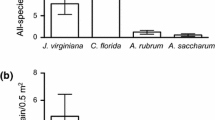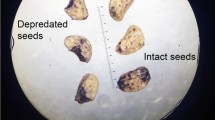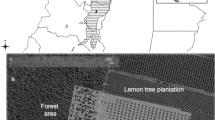Abstract
Mechanisms underlying biological invasion of highly disturbed ecosystems are well known, yet mechanisms responsible for biological invasion of undisturbed or weakly disturbed ecosystems are less understood. The triggering attribute (TA) approach, proposed as a mechanism that explains plant invasion success in undisturbed or weakly disturbed systems, considers that the spread of alien species depends on specific vegetative or regenerative traits in invasive species, discontinuously distributed in comparison to the resident community. In mountain Chaco woodland, fruiting phenology of ornithocorous invasive plants has been proposed as a TA, because it would allow invasive species to benefit from seed dispersal service, which is unused by native plants during a specific period of the year (winter). Under the seed dispersal ecology framework, we evaluated if fruiting phenology (fructification largely uncoupled with native species) of the fleshy-fruited invasive Pyracantha angustifolia affects bird fruit consumption, and allows the invasive to take advantage of the unused seed dispersal service during winter. If uncoupled fructification phenology represents a TA, seed disperser, seed predator, and pulp consumer diversity, abundance, and fruit consumption on P. angustifolia (which fructifies in winter), will be higher than on its exotic congeneric P. coccinea during summer, when fructification overlaps with native Celtis ehrenbergiana and many other native species. We found that: (1) disperser bird abundance and fruit consumption did not differ between P. angustifolia and P. coccinea; (2) the most diverse frugivorous assemblage was observed on C. ehrenbergiana, yet it had the lowest proportion of seed dispersers and the highest fruit consumption by seed predators and, (3) we also observed higher proportion of seed predators on P. angustifolia (uncoupled fructification scenario) than on P. coccinea (coupled fructification scenario). Our results suggest that invasive uncoupled fructification phenology does not represent a true TA which facilitates plant invasion processes in undisturbed or weakly disturbed ecosystem.




Similar content being viewed by others
References
Acosta A, Díaz S, Menghi M et al (1992) Patrones comunitarios a diferentes escalas espaciales en pastizales de las Sierras de Córdoba, Argentina. Rev Chil Hist Nat 65:195–207
Agresti A (1990) Analysis of categorical data. Wiley, New York
Aslan CE (2011) Implications of newly-formed seed-dispersal mutualisms between birds and introduced plants in northern California, USA. Biol Invasions 13:2829–2845
Aslan C, Rejmanek M (2012) Native fruit traits may mediate dispersal competition between native and non-native plants. NeoBiota 12:1–24
Bellis LM, Rivera L, Politi N et al (2009) Latitudinal patterns of bird richness, diversity and abundance in Polylepis australis mountain forest of Argentina. Bird Conserv Int 19:265–276
Buckley YM, Anderson S, Catterall CP et al (2006) Management of plant invasions mediated by frugivore interactions. J Appl Ecol 43:848–857
Burns K, Dalen J (2002) Foliage color contrasts and adaptive fruit color variation in a bird-dispersed plant community. Oikos 96:463–469
Cabido M, Funes G, Pucheta E et al (1998) A chorological analysis of the mountains from Central Argentina. Is all what we call Sierra Chaco really Chaco? Contribution to the study of the flora and vegetation of the Chaco. XII. Candollea 53:321–331
Cordeiro NJ, Patrick DA, Munisi B et al (2004) Role of dispersal in the invasion of an exotic tree in an East African submontane forest. J Trop Ecol 20:449–457
Crawley MJ (1987) What makes a community invasible? In: Gray AJ, Crawley MJ, Edwards PJ (eds) Colonization, succession and stability. Blackwell, Oxford, pp 429–453
Cronk QC, Fuller JL (1995) Plant invaders. Chapman & Hall, London
D’Antonio CM (1993) Mechanisms controlling invasion of coastal plant communities by the alien succulent Carpobrotus edulis. Ecology 74:83–95
Davis MA, Pelsor M (2001) Experimental support for a resource-based mechanistic model of invasibility. Ecol Lett 4:421–428
Delucchi G (1991) Especies adventicias y naturalizadas nuevas o críticas para la Argentina. Bol Soc Argent Bot 27:3–4
Demaio P, Karlin UO, Medina M (2002) Árboles nativos del centro de Argentina. Lola, Buenos Aires
Di Rienzo JA, Casanoves F, Balzarini MG, Gonzalez L et al (2011) InfoStat versión 2011. InfoStat, FCA, Universidad Nacional de Córdoba, Argentina
Elton CS (1958) The ecology of invasions by animals and plants. Methuen, London
Giorgis M, Tecco PA (2014) Árboles y arbustos invasores de la Provincia de Córdoba (Argentina): una contribución a la sistematización de bases de datos globales. Bol Soc Argent Bot 49:603–681
Gleditsch JM, Carlo TA (2011) Fruit quantity of invasive shrubs predicts the abundance of common native avian frugivores in central Pennsylvania. Divers Distrib 17:244–253
Godfree R, Lepschi B, Mallinson D (2004) Ecological filtering of exotic plants in an Australian sub-alpine environment. J Veg Sci 15:227–236
Gosper C (2004) Fruit characteristics of invasive bitou bush, Chrysanthemoides monilifera (Asteraceae), and a comparison with co-occurring native plant species. Aust J Bot 52:223–230
Gosper CR, Stansbury CD, Vivian-Smith G (2005) Seed dispersal of fleshy-fruited invasive plants by birds: contributing factors and management options. Divers Distrib 11:549–558
Greenberg R, Mettke-hofmann C (2001) Ecological aspects of neophobia and neophilia in birds. Curr Ornithol 16:119–178
Gurvich DE, Tecco PA, Diaz S (2005) Plant invasions in undisturbed ecosystems: the triggering attribute approach. J Veg Sci 16:723–728
Jordano P (2000) Fruits and frugivory. In: Fenner E (ed) Seeds: the ecology of regeneration in plant communities. CABI, Wallingford, pp 125–166
Jordano P, Schupp EW (2000) Seed disperser effectiveness: the quantity component and patterns of seed rain for Prunus mahaleb. Ecol Monogr 70:591–615
Jordano P, Garcia C, Godoy JA et al (2007) Differential contribution of frugivores to complex seed dispersal patterns. Proc Natl Acad Sci USA 104:3278–3282
Keane RM, Crawley MJ (2002) Exotic plant invasions and the enemy release hypothesis. Trends Ecol Evol 17:164–170
Kolar CS, Lodge DM (2001) Progress in invasion biology: predicting invaders. Trends Ecol Evol 16:199–204
Kueffer C, Kronauer L, Edwards PJ (2009) Wider spectrum of fruit traits in invasive than native floras may increase the vulnerability of oceanic islands to plant invasions. Oikos 118:1327–1334
Leffler AJ, James JJ, Monaco TA et al (2014) A new perspective on trait differences between native and invasive exotic plants. Ecology 95:298–305
Levine JM, D’Antonio CM (1999) Elton revisited: a review of evidence linking diversity and invasibility. Oikos 87:15–26
Lichstein JW, Grau HR, Aragón R (2004) Recruitment limitation in secondary forests dominated by an exotic tree. J Veg Sci 15:721–728
Lockwood JL, Cassey P, Blackburn T (2005) The role of propagule pressure in explaining species invasions. Trends Ecol Evol 20:223–228
Lonsdale WM (1999) Global patterns of plant invasions and the concept of invasibility. Ecology 80:1522–1536
Luti R, Solis M, Galera F et al (1979) Vegetación. In: Vasquez JB, Lopez Robles A, Sosa DF, Saez MP (eds) Geografía física de la provincia de Córdoba. Boldt, Buenos Aires, pp 297–368
Marler MJ, Zabinski CA, Callaway RM (1999) Mycorrhizae indirectly enhance competitive effects of an invasive forb on a native bunchgrass. Ecology 80:1180–1186
Maron JL, Connors PG (1996) A native nitrogen-fixing shrub facilitates weed invasion. Oecologia 105:302–312
Mokotjomela TM, Musil CF, Esler KJ (2013) Do frugivorous birds concentrate their foraging activities on those alien plants with the most abundant and nutritious fruits in the South African Mediterranean-climate region? Plant Ecol 214:49–59
Moles AT, Flores-Moreno H, Bonser SP et al (2012) Invasions: the trail behind, the path ahead, and a test of a disturbing idea. J Ecol 100:116–127
Montaldo NH (2000) Éxito reproductivo de plantas ornitócoras en un relicto de selva subtropical en Argentina. Rev Chil Hist Nat 73:511–524
Novara L (1993) Rosaceae. Aportes Bot Salta-Ser 2:1–53
Ordano M (1996) Estudio de una comunidad de aves altoserrana (Córdoba, Argentina) durante un ciclo anual. Rev Asoc Cienc Nat Litoral 27:83–94
Pyšek P, Richardson DM (2007) Traits associated with invasiveness in alien plants: where do we stand? In: Nentwig W (ed) Biological invasions. Springer, Berlin, pp 97–124
R Core Team (2012) R: a language and environment for statistical computing. R Foundation for Statistical Computing, Vienna
Rejmanek M, Richardson DM (1996) What attributes make some plant species more invasive? Ecology 77:1655–1661
Richardson DM, Rejmánek M (2011) Trees and shrubs as invasive alien species—a global review. Divers Distrib 17:788–809
Richardson DM, Allsopp N, D’Antonio CM et al (2000) Plant invasions–the role of mutualisms. Biol Rev 75:65–93
Sanchez Hümoller L (2009) Análisis de la dispersión de Celtis ehrenbergiana (Klotzsch) Liebm. en sitios fragmentados del Bosque Chaqueño. Thesis, Universidad Nacional de Córdoba
Santos BJ (1990) Árboles autóctonos argentinos. Tipográfica Editora Argentina, Buenos Aires
Schaefer HM, Schaefer V, Vorobyev M (2007) Are fruit colors adapted to consumer vision and birds equally efficient in detecting colorful signals? Am Nat 169:S159–S169
Schupp EW (1993) Quantity, quality and the effectiveness of seed dispersal by animals. Plant Ecol 107–108:15–29
Schupp EW, Jordano P, Gómez JM (2010) Seed dispersal effectiveness revisited: a conceptual review. New Phytol 188:333–353
Shea K, Chesson P (2002) Community ecology theory as a framework for biological invasions. Trends Ecol Evol 17:170–176
Solow AR (1993) A simple test for change in community structure. J Anim Ecol 62:191–193
Tecco PA, Diaz S, Cabido M et al (2010) Functional traits of alien plants across contrasting climatic and land-use regimes: do aliens join the locals or try harder than them? J Ecol 98:17–27
Tecco PA, Urcelay C, Diaz S et al (2013) Contrasting functional trait syndromes underlay woody alien success in the same ecosystem. Aust Ecol 38:443–451
Thompson K, Hodgson JG, Rich TC (1995) Native and alien invasive plants: more of the same? Ecography 18:390–402
Traveset A, Richardson DM (2014) Mutualistic interactions and biological invasions. Annu Rev Ecol Evol Syst 45:89–113
Vázquez DP, Morris WF, Jordano P (2005) Interaction frequency as a surrogate for the total effect of animal mutualists on plants. Ecol Lett 8:1088–1094
Willson MF, Whelan CJ (1990) The evolution of fruit color in fleshy-fruited plants. Am Nat 136:790–809
Zuur AF, Ieno EN, Walker NJ, Saveliev AA, Smith GM (2009) Mixed effects models and extensions in ecology with R. Springer, Verlag
Acknowledgments
We are very grateful to our friends Lisandro Fernández and Samia Cortez for their hospitality in the study site and fieldwork assistances. We are also grateful to two anonymous reviewers for their useful suggestions. This work was partially supported by a Rufford Small Grants, and a research grant by SECyT UNC (Res. 203-103). DLV-T is fellow at CONICET and SIP is researcher at CONICET.
Author information
Authors and Affiliations
Corresponding author
Electronic supplementary material
Below is the link to the electronic supplementary material.
Rights and permissions
About this article
Cite this article
Vergara-Tabares, D.L., Badini, J. & Peluc, S.I. Fruiting phenology as a “triggering attribute” of invasion process: Do invasive species take advantage of seed dispersal service provided by native birds?. Biol Invasions 18, 677–687 (2016). https://doi.org/10.1007/s10530-015-1039-4
Received:
Accepted:
Published:
Issue Date:
DOI: https://doi.org/10.1007/s10530-015-1039-4




